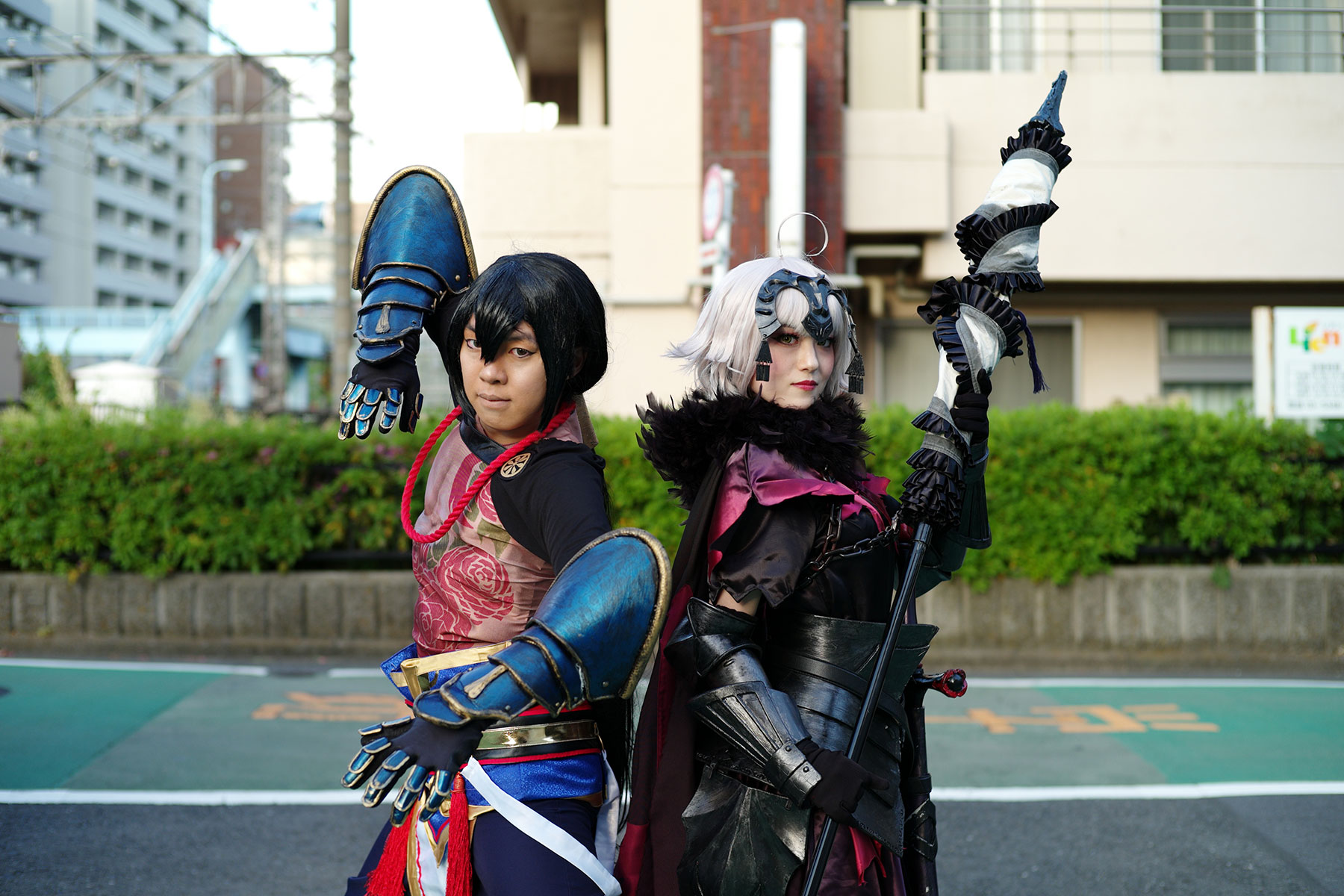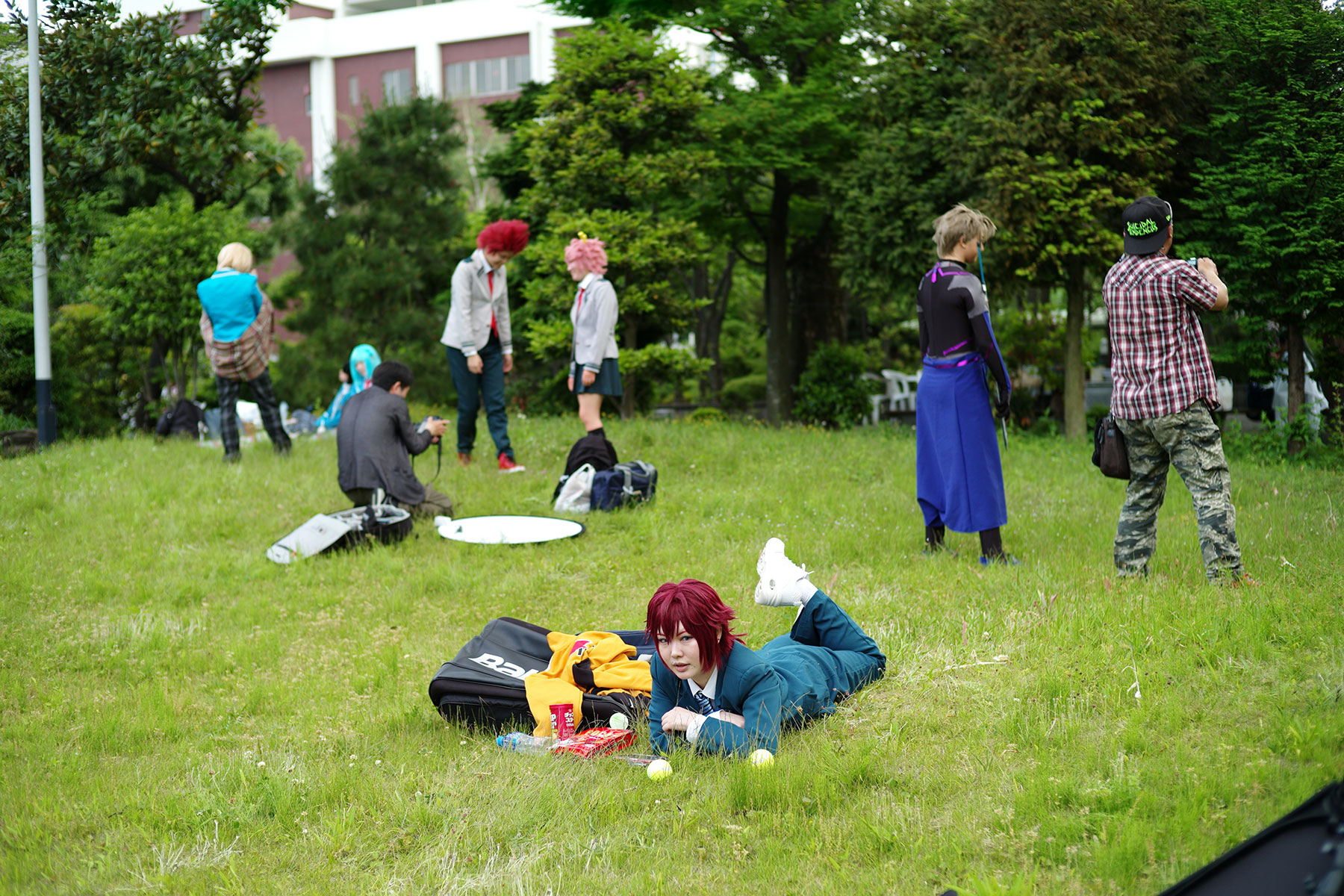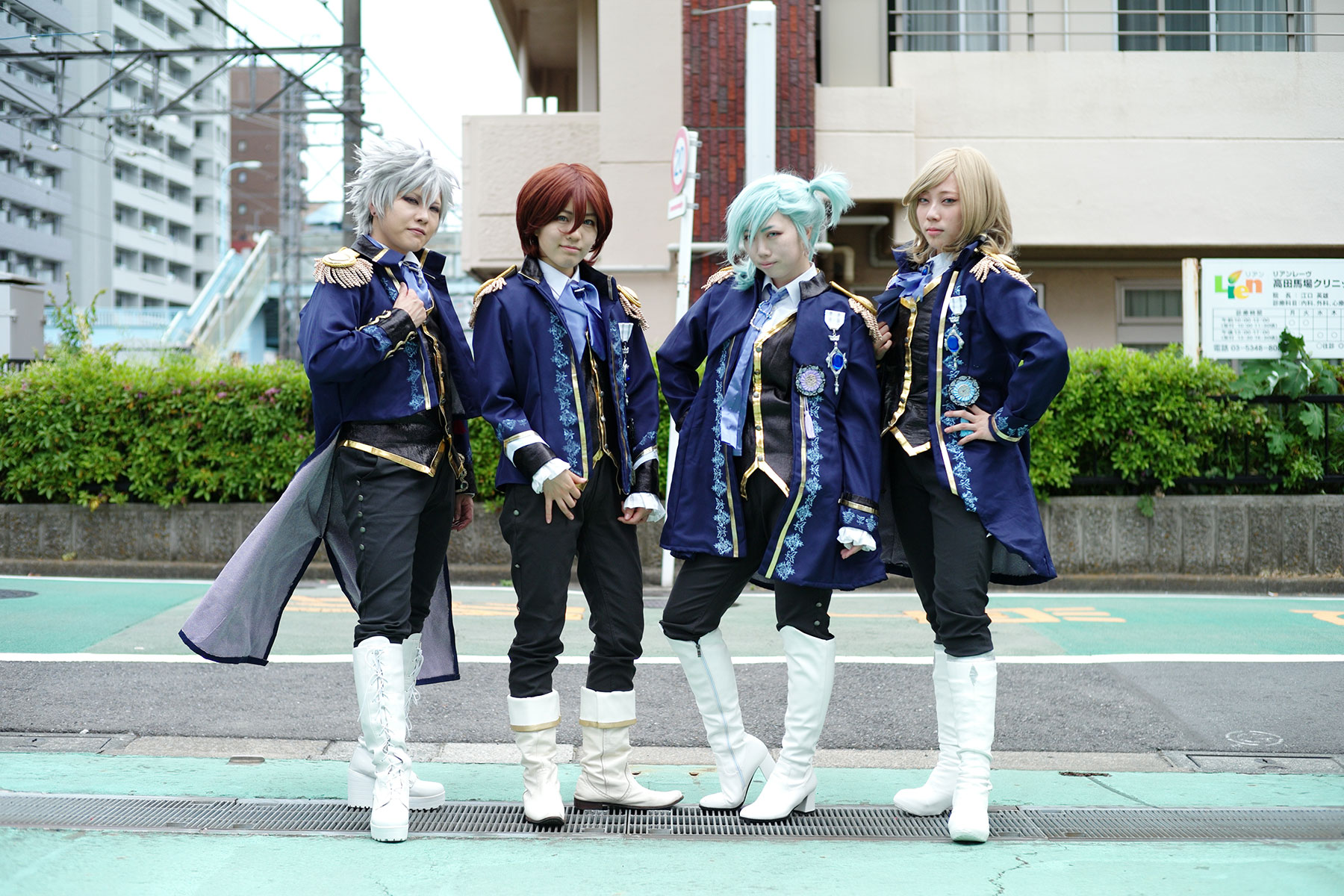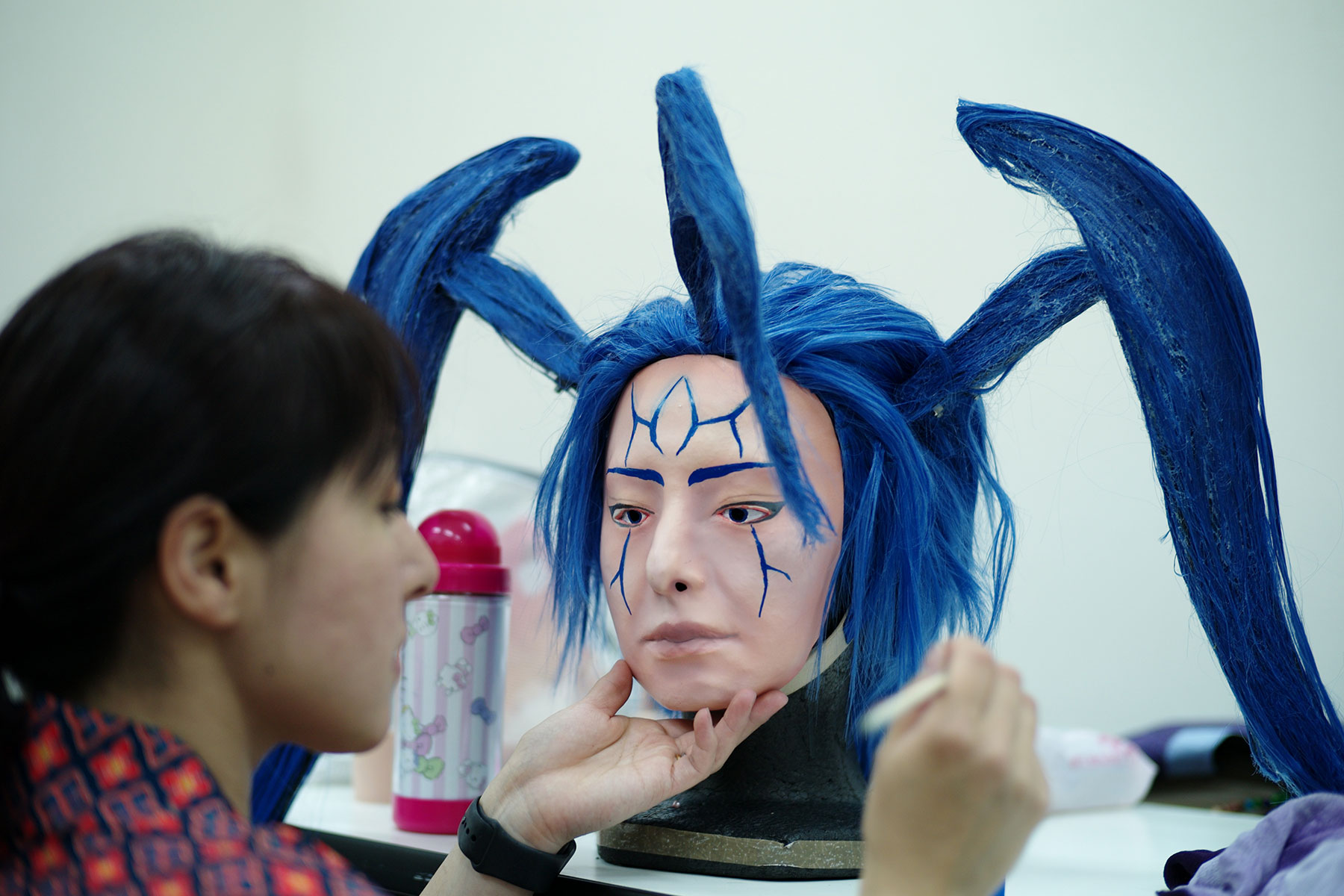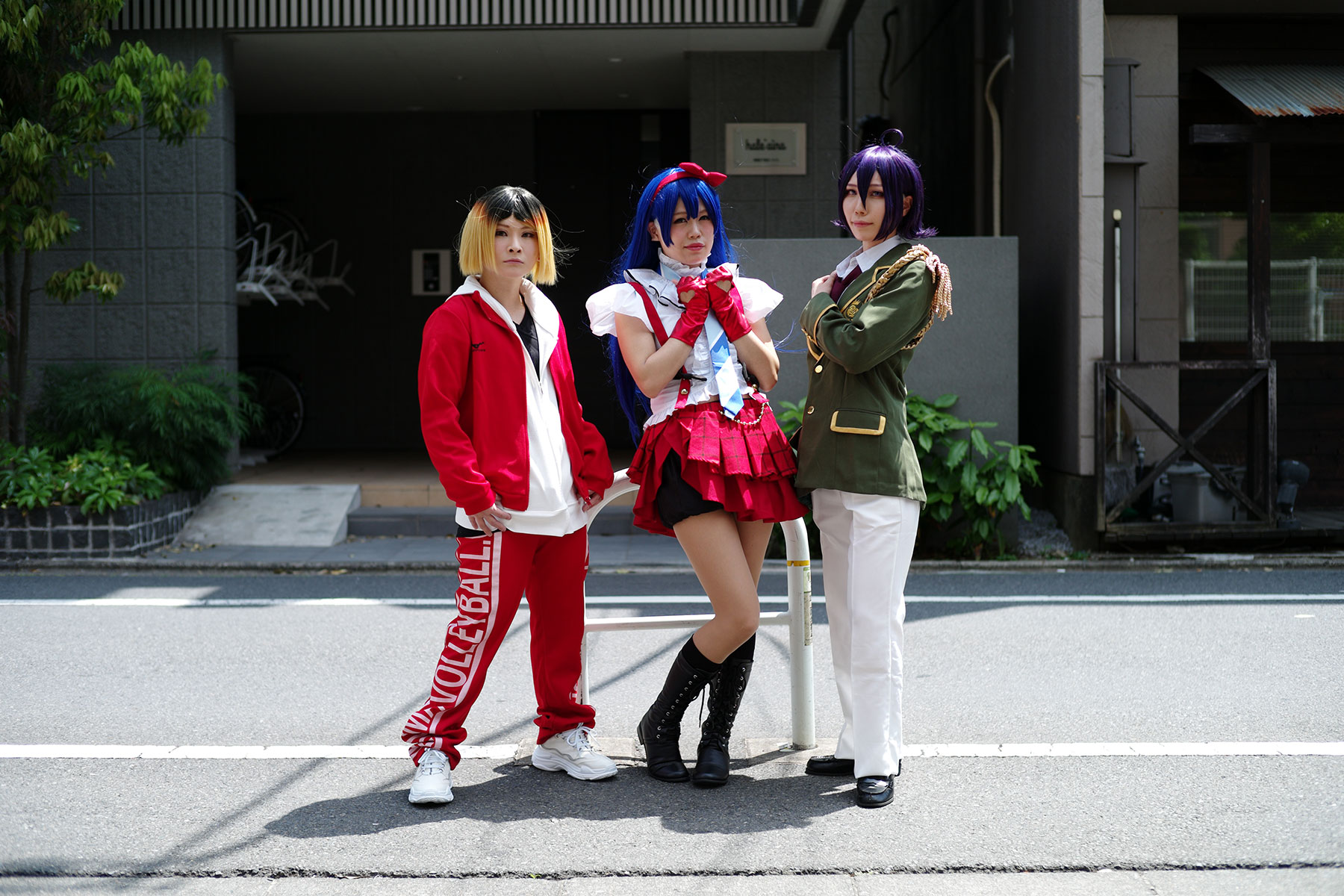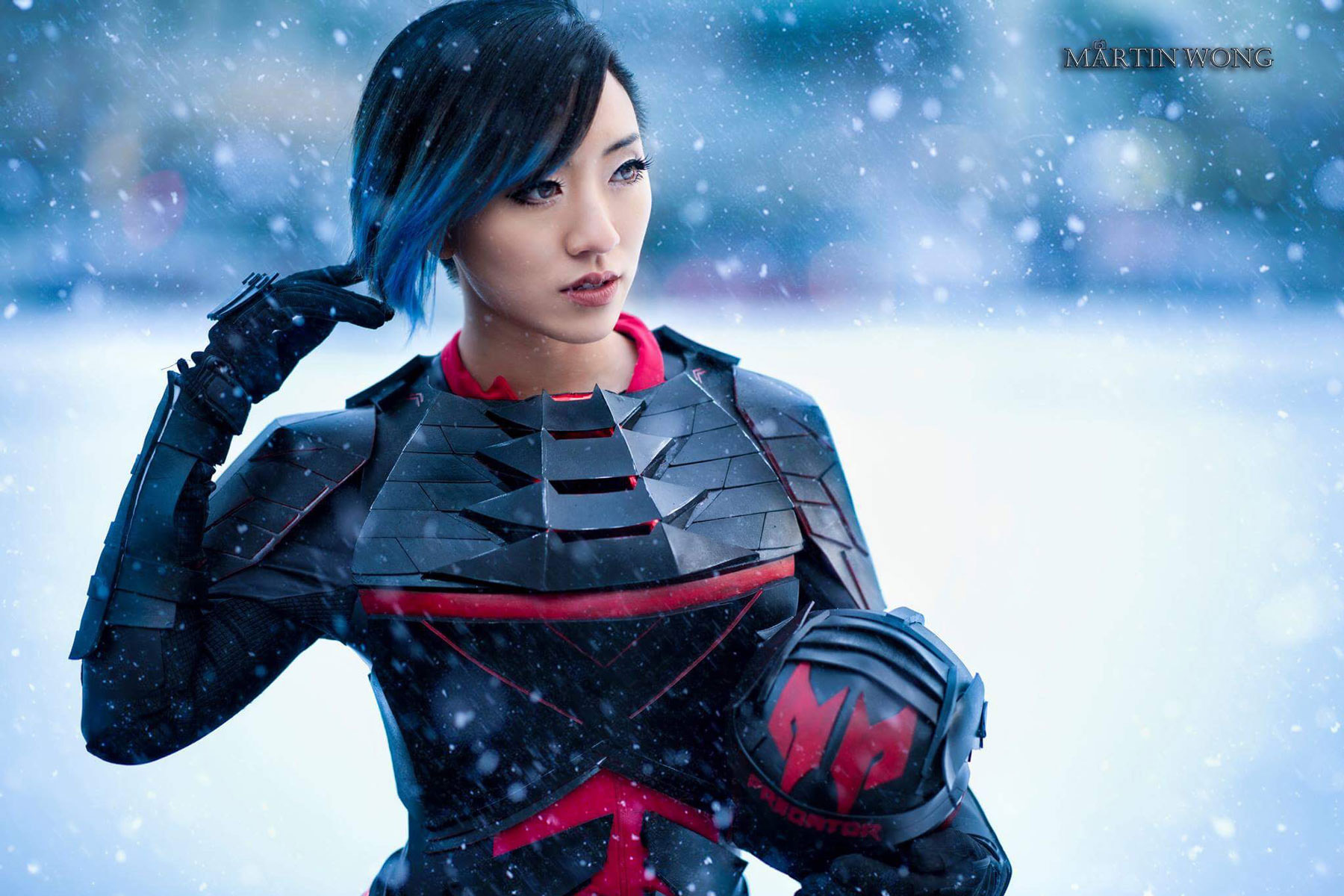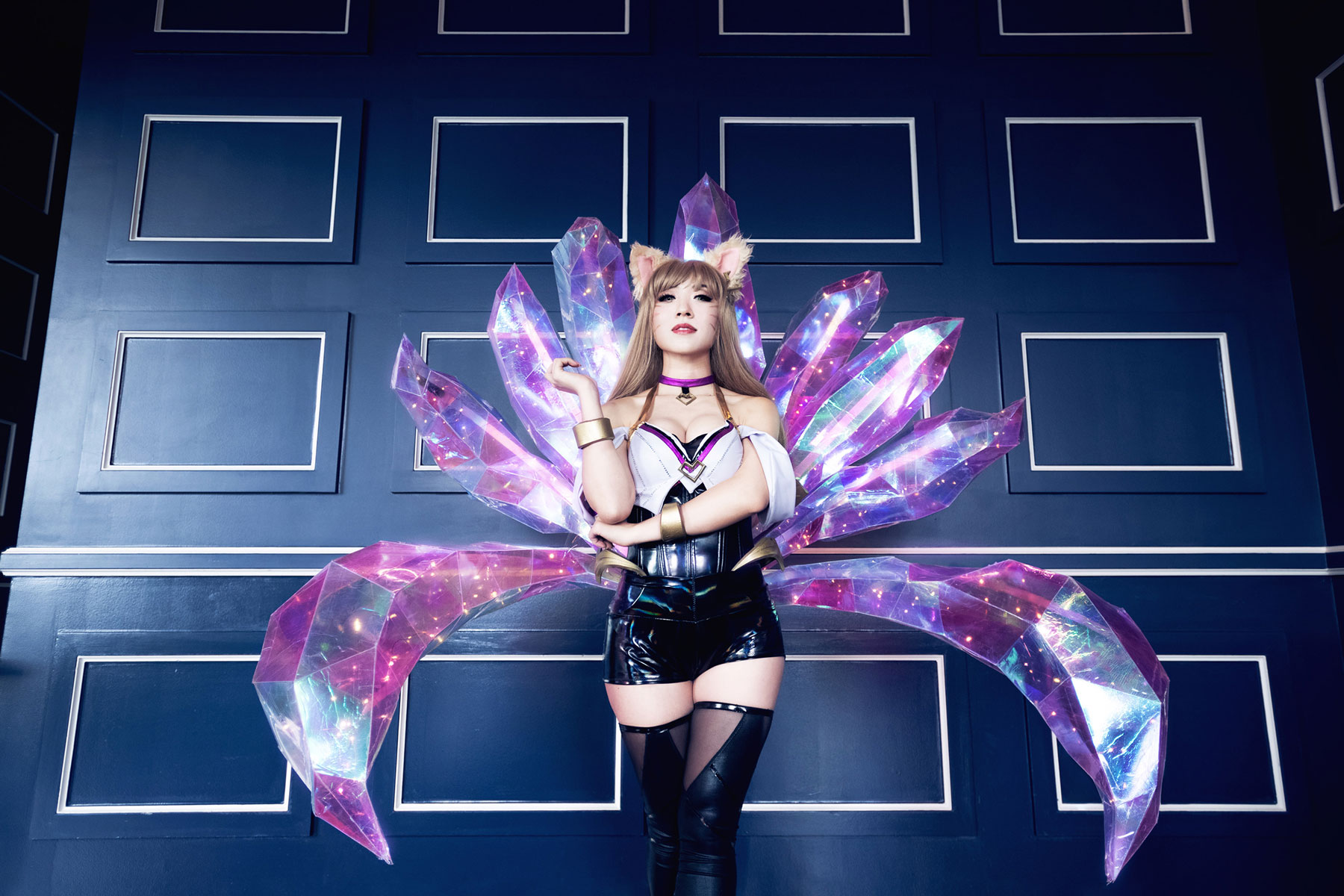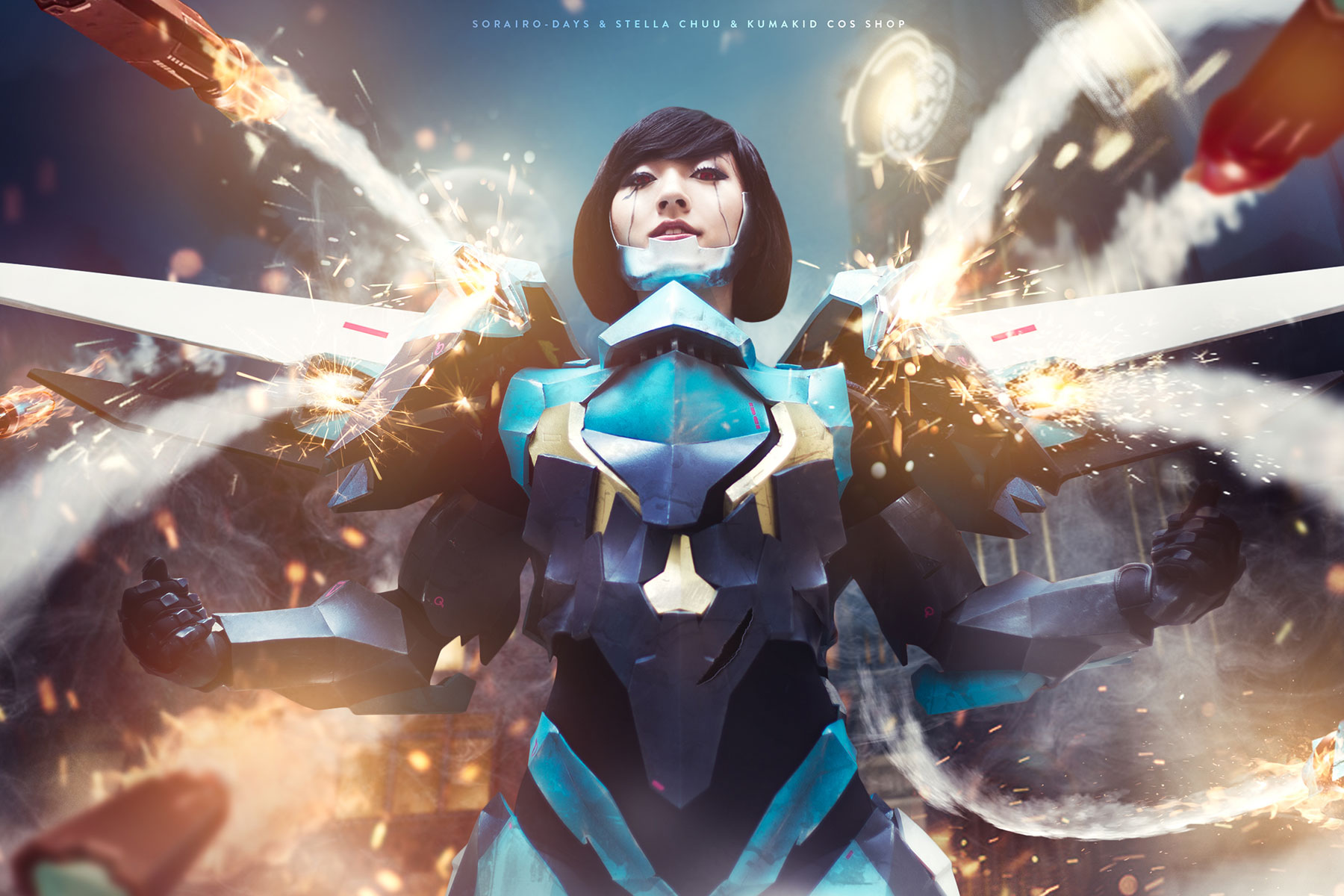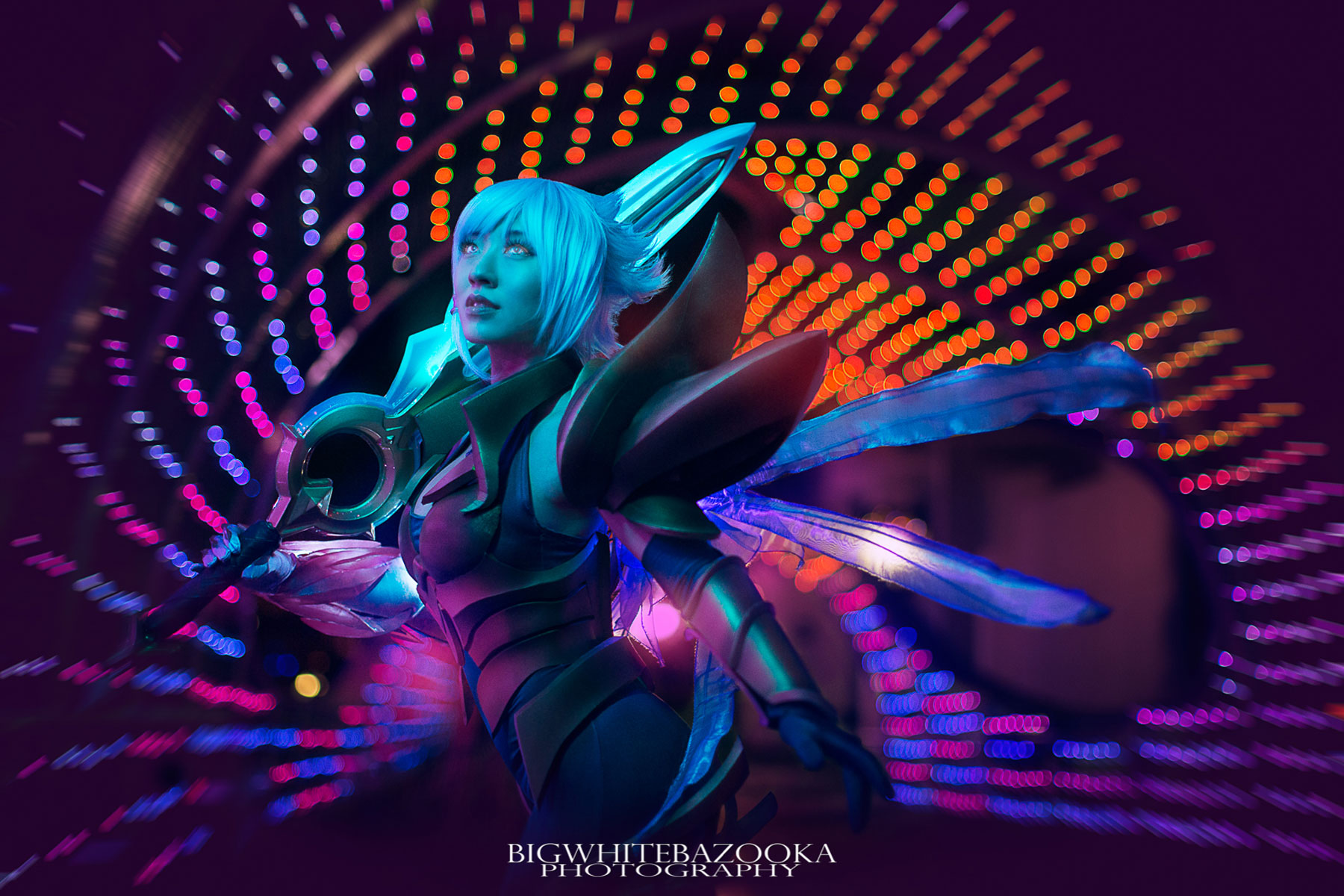CULTURE
Cosplay conquersthe world
Bubble-gum fashion: Professional cosplayer Stella Chuu poses in costume for a portrait. SORAIRO-DAYS & STELLA CHUU
The art of dressing up as characters from anime, manga, video games or TV shows has evolved into a global phenomenon
ANDREW McKIRDY
Staff writer
“Saki,” “Eri” and “Mimori” are having a tea party.
The three friends are sitting on a picnic sheet in a small public park in Tokyo’s Takadanobaba neighborhood, with a selection of cakes, quiches and pastries daintily arranged on plates in front of them.
Saki has black hair, while Eri’s is blonde with a thick curl obscuring much of her face. Mimori has turquoise hair, the same shade as her eyebrows. All three are wearing light blue school blazers that mark them out — to those in the know, at least — as characters from the smartphone game Ensemble Stars!
They are, if you hadn’t already guessed, cosplayers.
Saki, who is right-handed, reaches for a scone with her left hand and lifts it to her mouth.
“The character is left-handed, so it would be strange to eat with my right hand when I’m dressed like this,” she says. “I’ve gone to all the trouble of dressing up like this, so if my true self started showing through, it would be like I wasn’t trying to fully immerse myself in the character.”
Saki, Eri and Mimori are taking part in Tokyo Cosplay Collection, just one of thousands of cosplay events, big and small, held around the world each year.
Cosplay — the word itself is a portmanteau of “costume” and “play” — involves participants dressing up as characters from anime, manga, video games, TV shows or any other media of their choosing. Once in costume, cosplayers may attend conventions, take photos, enter competitions, perform theatrical routines or simply walk down the street with their friends.
“You can become a different version of yourself,” says another cosplayer attending Tokyo Cosplay Collection, who gives her name as Rio and is dressed as Kenma Kozume from the manga “Haikyu!!” “If you dress in a slightly different way, your personality changes with it.”
Despite tracing its origins to the 1939 World Science Fiction Convention in New York, cosplay has found its spiritual home in Japan. The term itself was coined by journalist Nobuyuki Takahashi in 1984, and the sheer volume of manga, games and anime that the country produces has kept cosplayers inspired for decades.
Over the years, however, cosplay has evolved into a genuine global phenomenon.
This month, cosplayers from all over the world will assemble in Japan for the July 27-Aug. 4 World Cosplay Summit. The annual event, which began in 2003, sees qualifiers from 42 different countries taking part in a series of shows and parades in Tokyo before heading to Nagoya to compete for the World Cosplay Championship title.
The World Cosplay Summit’s stated goal is to promote international relations through Japanese popular culture, and the event has support from three government ministries. Competition organizers describe Japan as “the holy land of pop culture,” and have invited entrants from countries as diverse as Saudi Arabia, Trinidad and Tobago, Chile and Bulgaria to take part.
“Being at the World Cosplay Summit was a dream for me, and I can’t believe I have the chance to experience this once more,” says Fabienne “Kalimsshar” Fauvin, who will be representing France with her partner, Allison “SakuraFlame” Picca. Fauvin also made an appearance at the competition in 2014. “Thanks to cosplay, I have the opportunity to travel a lot and meet cosplayers from different countries.”
Unlike casual cosplay events, where participants generally dress up to take photos, the World Cosplay Summit is a competition involving teams of two performing 2½-minute theatrical routines on stage in front of a panel of judges. The costumes must be handmade by the participants and must use Japanese titles as their source material.
The competition to decide Japan’s representative is held alongside Tokyo Cosplay Collection at Tokyo Fuji University, with five teams competing after coming through regional qualifiers in Tokyo, Kyushu, Hyogo and Tochigi.
The craftsmanship, innovation and attention to detail that have gone into each team’s costumes is staggering.
Hyogo team Gekidan Tatakau Joshi, comprising Yuri Inaba and Mai “Musso” Nakamura, has chosen to cosplay as characters from the video game Final Fantasy X. Inaba wanted to play two characters — Seymour and Jecht — within the course of the performance, but she knew it would be difficult to switch from one to the other quickly, given their radically different appearances.
The team’s solution was to make a full-size latex mask of Inaba’s face and attach it to a giant blue wig.
“First, you start with what looks like mud and you smear it all over the face,” Nakamura says. “She had to wait about 30 to 40 minutes for that to dry like concrete, with only holes in her nose to breathe through. When it’s dry, you peel it off and you’re left with the shape of her face. Then you put cement in and wait for it to dry. Then you’re left with something like a statue of her face, which you use to press the mask.”
Cosplayers pose before team performances at Tokyo Cosplay Collection in May. RYUSEI TAKAHASHI
Most competitive cosplayers teach themselves to make their own costumes and prop weapons, developing a wide range of technical skills in the process. The costumes can take months to make, and many go above and beyond the call of duty to ensure their creations are as faithful to the source material as possible.
“I know someone who cosplayed a super-simple costume — the guy is basically just wearing a suit,” says Lyndsey Luther, who runs the cosplay events at Anime Boston, one of the biggest anime conventions in the United States.
“But he had used historically correct techniques to make it fit to the body in exactly the right way,” she says. “It took hundreds of hours and you would never know it to look at it. He had spent hundreds of hours sewing all these itty-bitty details that you can’t even see from the outside.”
Before the stage performances to decide Japan’s World Cosplay Summit representative begin, the five teams are given a costume pre-inspection by a separate three-person judging panel. The teams are given seven minutes to explain how they made the costumes, with time at the end for judges to ask questions and take a closer look. Teams also bring photo books charting their costumes’ development for the judges to flip through.
Tochigi qualifier Team Ark, comprising Ayaka “Ruby” Matsuda and Ryota “RyuRyu” Ibi, has chosen to cosplay as characters from the smartphone game Fate/Grand Order. Matsuda tells the judges how she achieved the color gradation on her cape, while Ibi explains how he made her spear from a length of pipe and household items including a handle from a chest of drawers.
The costume pre-inspection scores are taken into account by the main seven-person judging panel, which evaluates the teams based on three criteria: performance, costume and respect for the character.
“Respect for the character is not so much about accuracy as passion,” explains judge Tatsumi Inui, who has come dressed for the occasion as Fate/Grand Order character Shakespeare. “How much does the cosplayer love this character? You can sense that from the way they express themselves.
“A separate panel pre-judges the costumes beforehand, but the costume points that our panel awards are based on how good they look on stage,” he says. “When they swish their cape, how graceful is it? Does the skirt twirl round in a perfect circle? We award points for the elements of the costumes that are meant to be seen.”
In the end, Team Ark is declared the winner, and Matsuda and Ibi pose for photos and talk excitedly about representing their country at the World Cosplay Summit.
Not all cosplayers are as dedicated to their craft as those who will be competing in Nagoya, however. For the majority, cosplay is simply a hobby.
Most participants at Tokyo Cosplay Collection have bought, rather than made, their outfits, and say they like cosplay because it gives them the chance to “become” their favorite character for a day.
In the park where Saki, Eri and Mimori are enjoying their tea party, groups of cosplayers are posing for photos in the early afternoon sun. Many have come with amateur photographers with whom they have struck up mutually beneficial relationships.
A photographer who posts pictures on social media under the name “Barter Cat” has been invited to take photos of two cosplayers he knows from a previous event, who have dressed as characters from the manga “My Hero Academia.” Photographing cosplayers is Barter Cat’s hobby and the couple are keen to have their pictures taken, so no money is involved.
The rules governing their relationship are clearly defined, and Barter Cat is careful never to cross the line.
“They asked me to come here today so I will only take pictures of them,” he says. “Between photographers, we try not to interfere with what each other is doing. I don’t know what kind of relationship other photographers and models have but, in my case, there is a distance between us. They want me to take photos and I want to take photos, so our communication in based on that. I don’t think about anything beyond that.
“I’m sure there are shady photographers who act like stalkers,” he says. “When you have big crowds, people like that will come along. That’s just a fact.”
The issue of consent and boundaries in the world of cosplay is a pertinent one. The majority of cosplayers are women, and many of the characters they portray wear revealing or form-fitting outfits.
Incidents of sexual harassment, groping and taking pictures without permission have been widely reported over the years, but a campaign to raise awareness called Cosplay Is Not Consent, which was launched at New York Comic Con in 2014, has helped to change attitudes.
“People didn’t really know the best way to treat a cosplayer,” says Stella Chuu, a 30-year-old professional cosplayer who lives in Los Angeles. “They would take a picture as they would with a friend, so they would put their hand around our waist or they would hug us. But you don’t just hug a stranger randomly.
“So we had this whole movement called Cosplay Is Not Consent, and it’s just a way to remind people that we’re not objects,” she says. “We’re human beings. Don’t take pictures of me when I have a cheeseburger in my mouth or when I feel really tired.”
Chuu has been a professional cosplayer since 2016. Only a handful of people worldwide are able to make their living solely from cosplay, but the fact that some do is evidence of how far an activity that was once confined to the margins has entered the mainstream.
Professional cosplayers generally either build and sell costumes and props to order, or create content similar to YouTube and Instagram personalities. Chuu falls into the latter category, and spends her time building costumes, making videos and tutorials, following trends, making guest appearances and engaging on social media. Game or TV companies will also hire professional cosplayers to make appearances promoting their products at conventions.
“They realized that hiring models from model agencies is a waste of marketing money because people just see those models as models, not people who are actually part of the fan base,” Chuu says. “They might as well just be props. When a cosplayer comes in and they build a costume for something that they really care about, and they understand what the reference material is, it really bridges the gap between the company and the fan base.”
Chuu says she has no regrets about quitting her regular job to become a full-time cosplayer, and she considers herself lucky to live in an era where the internet has made it possible.
She does admit, however, that making the transition from hobby to profession has not been without sacrifice.
“I think the only thing that took the fun out of it is the sheer quantity that I need to put out,” she says. “I can’t just take my time. I can’t just relax and be lazy. Every day is a day of work for me. Every day, I’m producing content somehow and, if I’m not making costumes, I’m filming a video or I’m traveling or I’m collaborating with different projects.”
Despite being a professional, Chuu claims she is “not good enough” to enter competitions like the World Cosplay Summit, which she says features cosplayers with “ridiculous” skills.
That certainly applies to the competition to name Japan’s representative in Nagoya, and it is a measure of the stratospheric standard that Gekidan Tatakau Joshi, featuring the mask-wearing Inaba — a World Cosplay Summit champion in 2009 — does not make the cut.
For some cosplayers in and around the venue, however, simply being there in costume is an impressive enough achievement.
“Cosplay has become much more widespread,” says Saki, as she picks up another scone with her left hand at the tea party in Tokyo. “We’re talking about a long time ago but, in the past, we wouldn’t have been able to cosplay in a place like this. The events were all held in small community centers. There weren’t any where you were allowed to go out and walk about the streets.”


